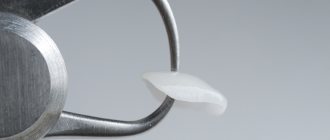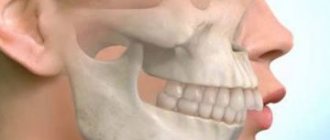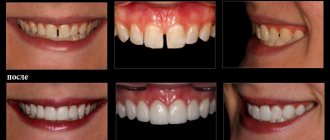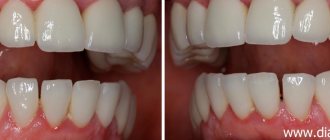A beautiful smile undoubtedly matters to a person. After all, this is what many people fix their attention on when they meet. A smile leaves an unforgettable impression on the interlocutor. It plays an important role in your confidence when communicating. A beautiful smile will improve contact with your interlocutor, improve behavior and leave behind all sorrows and self-doubt, and will also melt the heart of any stranger. But if the smile is not perfect and there is a defect in the front teeth (cracked dental plate, extracted tooth, crooked bite or tooth fragment, caries), how can we talk about self-confidence? Such a person will become isolated from others, become withdrawn, stop smiling, and will feel awkward when communicating. All this can leave a mark on a person’s profession and on his personal life.
No one wants to show problems with their front teeth to others, so dentures are the best solution for such patients.
When performing prosthetics after removal, it is important to restore and preserve the functions of the organ:
- Correct bite;
- Shape;
- Natural color;
- Gum health.
Prosthetics of the front teeth is also an aesthetic issue, therefore, to create a beautiful smile, it is necessary to use high-quality, durable materials that will visually look good. In dentistry, several methods of installing dentures are used and leading materials are used to give each patient a dazzling smile.
The main indications for the use of anterior dental prostheses are:
- Cracks in the dental plate, chips, broken teeth;
- Lost teeth or congenital adentia;
- Carious teeth;
- Crooked bite;
- Yellowing or darkening of the enamel;
- Crooked teeth, irregular shape and uneven “facial” surface of the tooth;
- Early unsuccessful prosthetics.
To solve your problem and select the correct method for installing dentures after removing your front teeth, you can consult the Dr. Levin dental clinic by calling the clinic.
Prosthetic options for anterior teeth
- Temporary and permanent;
- Removable and non-removable.
Temporary prostheses are needed for emergency filling of the defect. This option is performed for a broken tooth, extraction, and when removing or replacing other dentures. To do this, temporary plastic prostheses or removable dentures are used to close the existing defect. The wearing period of such implants is 30-60 days. This time will be enough to make a permanent prosthesis and sanitize the oral cavity.
Permanent prosthetics are performed after the root implant has healed, with healthy neighboring teeth, and in the absence of inflammatory changes in the oral cavity.
Removable prosthetics can be used in people who, due to contraindications, cannot currently perform such a procedure and it is postponed for some time. Or when it is not possible to install a prosthetic bridge due to the lack of more than four teeth in a row or the supporting teeth are damaged. Such patients are recommended to wear removable dentures.
Fixed prosthetics are carried out according to indications and include the following techniques:
- Implantation;
- Bridge prosthetics;
- Installation of crowns;
- Installation of veneers or lumineers.
There are several options for prosthetics of the upper and lower front teeth
What implants to install?
A person planning to get dental implants usually wonders what type of implant to choose. The answer to this question requires taking into account a number of factors:
- the need for dental restoration;
- analysis of prosthetic options;
- accounting of financial capabilities;
- awareness of moral readiness and free time to practice prosthetics.
The dental implantation technique is expensive and time-consuming; it can last up to 4 months, during which the implanted implant grows in and a crown is placed on it. You can also use prosthetics using the usual method.
Implantation of artificial teeth
A modern, long-lasting option for the restoration of front teeth is implantation. This operation involves inserting a special pin into the jaw bone, in the place where a tooth is missing, which will act as a tooth root and will counteract atrophic changes in bone tissue. This pin is made of titanium and does not cause any inconvenience or complications in the future. Then a crown made of ceramic is installed on this titanium rod. Implantation makes it possible not to touch the healthy teeth in the neighborhood. For this procedure, high-quality durable implants from the Nobel Biocare brand are used, which are guaranteed for life. The implanted tooth will not differ in any way from the rest, since the crown is made after measurement and exactly matches the shape and natural shade of the teeth. Another technique for using dentures on the front teeth is installing a bridge.
The name “bridge” was borrowed from technicians, since its installation uses the principle of constructing bridges. A bridge is a type of permanent dental prosthesis; they are used to replace defects of several teeth (up to four) in a row. To do this, special crowns are installed on the adjacent good teeth, between which the prosthesis will be placed. The negative quality of this technique is the need to grind down the surface and remove the pulp of healthy teeth on which crowns will be placed. The bridge also needs to be replaced at least once every few years. But with these disadvantages, this method allows you to avoid surgical intervention.
Implantation in one day: Top 5 myths and reality
- Myth No. 1.
All implantation work can be completed in one visit. Reality: the process of implantation actually takes place in one visit. However, to make the diagnosis, CT scan and impression, one or two more appointments are needed. - Myth No. 2.
Implantation is contraindicated in case of periodontal disease. Reality: implantation for periodontal disease and periodontitis is rather an indication or even the only way out to have a normal dentition. - Myth No. 3.
Dental implantation is painful. Reality: Implant placement always takes place under local anesthesia. Particularly impressionable patients can perform it under sedation and wake up when everything is ready. - Myth No. 4
. Implantation is expensive. Reality: There are budget and luxury options on the implant market. In addition, over the years the service has become more and more accessible, and many clinics hold promotions for implantology services. - Myth No. 5.
An implant is a foreign body; the body will definitely reject it. Reality: modern implants are made of biocompatible materials and take root in 99% of cases.
Prosthetics of anterior teeth using crowns
Sometimes lesions on the front teeth can be more serious. Then prosthetics of the front teeth using crowns is suitable. To make the most natural shape of the tooth being installed and to ensure a tight fit of the crown, it is necessary to grind the affected tooth and, if necessary, remove the pulp and nerve. Then process and seal the canals. After fitting, a ceramic crown is installed on the dental cement mortar. Ceramic or zirconium structures without metal are best suited for dental prosthetics.
The main advantages of such crowns are:
- The base from which the dentures are made must be hypoallergenic. Which is very important. Ceramic crowns do not cause allergic reactions.
- Ceramic crowns look aesthetically pleasing. Based on individual measurements and subsequent fitting, you can ideally select the desired shape and color that will match the natural shade of natural teeth.
- Metal-free crowns do not cause darkening of the gums around the installed tooth and do not leave a metal rim. They also do not lead to alveolitis, gingivitis and periodontitis.
- Ceramic crowns will not cause discomfort when eating food at different temperatures.
- Also, such crowns are lightweight, comfortable and durable.
How to choose a specialist
The first thing you should pay attention to is the availability of diagnostic equipment in dentistry. If you were sent to another clinic for a CT scan of your teeth and oral cavity, you should think twice. Modern equipment should be in every serious medical center.
Second, no less important, is the doctor’s experience in the field of implantology. Due to the complexity of the process, the specialist must have experience in performing the operation in this particular direction. Before your consultation, try to educate yourself about the different methods of immediate loading implantation and ask enough questions to the specialist to assess his level of professionalism.
Prosthetic replacement of anterior tooth after extraction
After tooth extraction, it is better to do its prosthetics using the express implantation technique, in the absence of contraindications. To do this, immediately after tooth extraction, an implant and a special abutment are installed in its alveolar socket to form the correct gum shape. A crown is temporarily placed on it. After the implant has healed for approximately several months, a permanent crown is installed.
The advantages of express implantation include:
- This procedure does not require any additional incisions, which is less traumatic to the gums;
- The implant is installed in an open manner, which also does not require additional surgical intervention;
- This method is perfect for patients who do not want to wait until the hole heals and a bridge or crown can be installed.
- Short healing period;
- There are few side complications that are unpleasant for the patient.
conclusions
When choosing a method of dental prosthetics, several factors should be taken into account:
- affordability;
- level of general health;
- structural features of the jaws;
- advantages and disadvantages of dental prosthetic techniques;
- time for the procedure and moral readiness for it.
Before contacting a dentist, it makes sense to look at materials on this topic on the Internet in order to understand the essence of various prosthetic methods with their detailed descriptions and expert reviews. The doctor will tell you more when you visit the clinic; he will be able to take into account all the factors influencing the choice of the optimal denture technique.
Installation of dentures for anterior teeth without turning
This is the restoration of damaged teeth, when the neighboring teeth intended for support are not ground down or depulped. In this case, it is worth performing implantation. This is one of the most gentle and atraumatic methods of installing upper and lower teeth. The essence of the method is that in the place of the lost tooth, an implant is installed in the jaw bone tissue, which performs the function of a root. Subsequently, a crown is put on it.
There are also methods that do not require grinding of a layer of healthy teeth, but they are rather temporary.
Studying price lists
After choosing a clinic, you need to understand how much it costs to insert a tooth, what are the prices per “unit” for a particular method. The cheapest option would be a removable plastic prosthesis, the most expensive would be an implant. If you need to insert a tooth using this method, the price may be quite reasonable, but if you need to insert the teeth completely, then it is better to use the “all on 4” method. In this case, only four implants are installed, onto which the entire jaw structure is attached. This not only makes the procedure cheaper, but also reduces time costs.
If you need to replace several teeth, you can use clasp or bridge structures. They are much cheaper than implants, but they will not protect you completely from loss of bone tissue.
Veneers and Lumineers
Veneers and lumineers can be used as aesthetic options for dentures on the front teeth. Veneers are very thin shells of porcelain that are given a color similar to the natural color of the patient's teeth. Veneers completely match the shape of a natural tooth. Such plates are attached to the front surface of the tooth.
Lumineers are transparent and very thin plates about 0.15 mm thick. Placed on the front surface of the tooth. This cosmetic procedure is non-invasive, quick, painless and long lasting.
These qualities determine the indications for the installation of veneers or lumineers:
- Crack and small chip of a tooth;
- Yellowing or darkening of tooth enamel;
- Uneven frontal surface;
- Crooked teeth.
Choosing where to get treatment
You can choose a dental clinic based on price level, but you just need to make sure that they can help you there. Sometimes it happens that someone’s teeth were inserted poorly, after which complications arose or the result turned out to be unaesthetic. Typically, such patients leave unflattering reviews about a medical institution or a specific doctor. They also write where they went next, and where they managed to fix everything. However, you should not completely rely on these reviews. After all, if a person writes and does not know what kind of doctor he is who inserts teeth, what his specialty is called, then is it worth trusting such assessments? Anyone who actually underwent treatment knows for sure that he consulted an orthopedist or orthodontist, that the prosthesis was made by a dental technician - and this is a different specialist, and that the preparatory work was done by a dental therapist. In small clinics, a doctor can combine the work of an orthopedist and a therapist, but never also act as a dental technician!
So it’s always better to rely on the choice of your friends rather than on the opinion of a stranger who left a review on the site. Such a person could be hired by competitors to ruin the reputation of the dental clinic.
Installation of prosthetic anterior teeth on the upper and lower jaws
The use of dentures for the lower and upper anterior teeth is almost the same from a practical point of view. The difference may lie in the fact that the installation of dentures for the upper teeth requires more attention from the dentist, since the upper jaw is somewhat less well supplied with blood than the lower jaw, hence healing here will take a little longer. And also, when a person smiles, the front teeth are the first to be seen from above, so it is necessary to pay more attention to the aesthetic side of prosthetics.
Preparing for dental prosthetics
Many people do not like any dental procedures, and this is due to the fear of unbearable pain. You should not be afraid of dental prosthetics, since the most unpleasant thing you will encounter is tooth grinding and depulpation. And all procedures are carried out using local, good, strong anesthetics.
An important diagnostic point is x-ray examination to determine the number and size of roots.
Other stages of preparation include the improvement of neighboring teeth (removal of plaque, treatment of carious damage), which will serve as a support for the prosthesis. If the tooth is significantly damaged, they resort to extraction, treatment of the canals and their subsequent filling.
For prosthetic treatment of anterior teeth, as for any other manipulation, there are contraindications. They are divided into absolute and relative.
Absolute contraindications include:
- 3-4 stages of cancer;
- Conditions after chemotherapy;
- Immunodeficiency conditions;
- Severe somatic diseases in the stage of decompensated state;
Relative:
- Diabetes mellitus (especially type 1);
- Diseases of the heart and blood vessels, such as hypertension with crisis and angina pectoris;
- Smoking, alcoholism;
- Mental disorders;
- Pregnancy;
- Allergic reactions to dental medications and materials.
When an alternative to dental implants may be needed
Not everyone can get implantation. Contraindications for surgery:
- mental pathologies;
- immunodeficiency states;
- cancer;
- decompensated diabetes mellitus;
- rheumatism;
- problems with blood clotting;
- diseases of the central nervous system;
- diseases of bone tissue;
- inflammatory processes;
- severe heart pathologies;
- renal failure;
- increased sensitivity to antiseptics;
- age up to 18 years.
The list of contraindications varies depending on the implantation method. In addition to the restrictions on installing titanium roots, implantation has other disadvantages:
- relatively high cost of treatment;
- risk of implant rejection;
- the likelihood of damage to the maxillary sinuses (with prosthetics in the upper jaw row);
- complexity of the operation (the integrity of soft, bone tissue, nerve endings and mucous membranes is damaged - postoperative swelling and pain occur).











